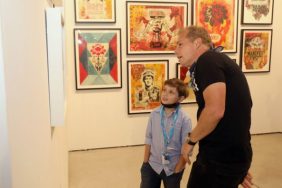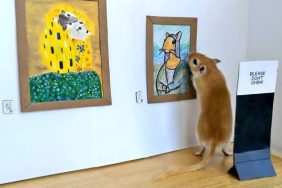Installation view of Gavlak Gallery Ten Year Anniversary Exhibition. Photo: Jeff McLane.
The gallery business is a fickle one. How does a gallerist interpret and work with market trends while also focusing on the joy of the art that most excites them, which is usually why they opened galleries in the first place? Gallerist Sarah Gavlak seems to have cracked the code. She recently celebrated the 10-year mark of her gallery, which has branches in both Palm Beach and Los Angeles. With a program that’s focused on women and queer artists, it’s exciting to see what change has taken place, and where the gallery will go in the future. CRAVE got in touch with Gavlak to learn more about what it’s been like to run a successful bicoastal gallery.
Alicia Eler: What was it like transitioning from running one small gallery in Palm Beach to two in LA and Palm Beach simultaneously?

Sarah Gavlak. Photo: by Firooz Zahedi.
Sarah Gavlak: Going from running one small gallery to running two galleries, one being very large and very busy year-round, has been challenging. I have to travel very consistently, and my staff has had to grow immensely. I am so thankful that I love what I do, because that keeps me energized. Both my passion and my incredible team help to make it all work, and without those things running both spaces would be impossible. It’s hard work to run two galleries on opposite sides of the country, but I’m happy to be taking on that challenge.
Aside from the challenge of the transition from one to two gallery spaces, another challenge for me has been that my interests have always been much more based in the academic rather than the business or commercial side of art. I’ve had to learn the business side while on the job, and while building my gallery, over the years. I’m still much more comfortable talking about art history and artists ideas rather than market trends or market value. While the art world has changed incredibly in terms of the market over the last 10 years, it’s much more meaningful for me and much more true to who I am to continue to focus on the art history and academic aspects of art, rather than the commercial side of art.
Let’s talk about where you’re at with your programming here at the 10-year mark. What sort of creative program do you feel like you’ve built thus far, and where do you see it going in the next five years?
I can see that over the years what I’m interested in has evolved only somewhat, and that the core of my interests has always remained the same. I’m not interested in trends, and I never have been. I’m interested in artists who have studied the history of art, who understand art, and artists who go to museums and actually look at art, because that’s what I do. When I opened my gallery 10 years ago, my roster was all women artists as well as a few gay men. I still to this day represent a majority of women artists, and as both a feminist and a woman interested in feminist theory, it seems it’s now a trend for galleries and museums to do shows with women artists. My question to these galleries and museums: Where were you 10 years ago? And, are you going to continue to put your money where your mouth is, or is this only a trend? I see myself continuing to add and focus on women and LGBTQ artists for the next 10 years and onward. That sentiment has never been a trend for me, and of course I hope for others it’s not a trend either.

Marnie Weber, “Pink Bed”, 2001. Copyright Marnie Weber. Photo: Jeff McLane.
In your opinion as a seasoned gallerist, what is it about LA that makes it so exciting and vibrant right now?
For me LA has the same attraction and pull that it did back in 1991 when I moved to Los Angeles for the first time. It’s still the wild west as it was in the 1990’s, meaning the people in LA are free to create as they want, and they do. Things are very rigid back East, where I’m from. More ideas are embraced in Los Angeles, it’s much more open. You can really feel that there is a lot of excitement and energy here.
Tell me about the community that you’re in now, in this part of Hollywood.
I couldn’t ask for better neighbors. There are fantastic galleries in this area, including Regen Projects, Hannah Hoffman, Various Small Fires, and Redling Fine Art. Not only am I surrounded by galleries run by incredible and brilliant women gallerists, but I also genuinely love the neighborhood we’re in. The area is gritty and in transition, and I hope that never changes.

Installation view of Gavlak Gallery Ten Year Anniversary Exhibition. Photo: Jeff McLane.
The 10 year anniversary show is such a lovely selection, with people you started working with years ago, like Wade Guyton, and then I recognize Betty Tompkins, Scott Reeder who I know from Chicago and Simone Leigh. How did you select the pieces to be in this show, and what do they mean to you?
For the 10 Year Anniversary exhibition I wanted to tell the story of the gallery, and show what we’ve been doing for the last 10 years. There is an incredible Sheila Hicks piece from 1964 in the LA show that I exhibited in Palm Beach back in 2008 along with T.J. Wilcox and Pae White. There is also a Marilyn Minter painting from 1993 in the LA exhibition, as I showed Marilyn in Palm Beach back in 2006. Works by Scott Reeder are in the Los Angeles 10 Year Anniversary exhibition, as I’ve shown Scott in Palm Beach in both 2008 and 2011. The 10 Year Anniversary exhibition also features works by artists I’ve recently begun working with – artists like Amy Bessone, Michael Manning, Dean Sameshima, Lily Stockman, Marnie Weber, and Brian Wills – and this part of the exhibition is very exciting to me, because the focus is on the future.








